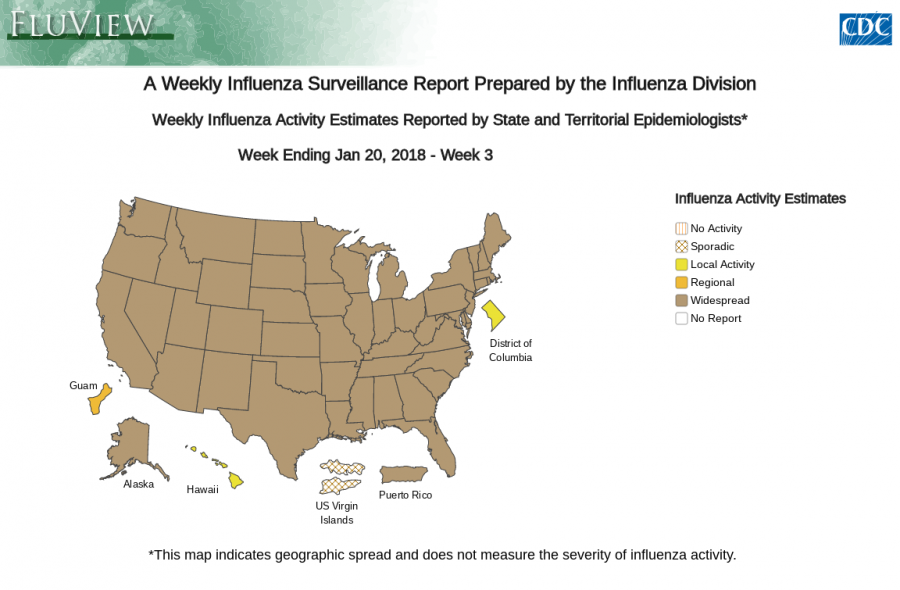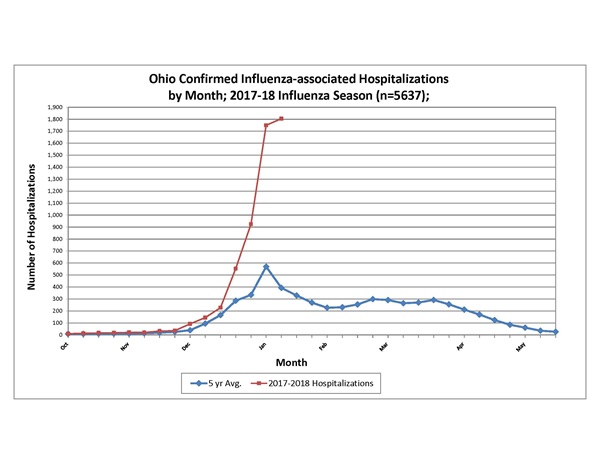Flu Season Reaches Widespread Status Across the U.S. and Causes Record Hospitalizations in Ohio

The flu virus has been a common problem among people, spreading across every state except Hawaii and often affecting young children and adults over the age of sixty-five.
Centers for Disease Control and Prevention (CDC) said that in the first week of January, flu activity has increased. As of January 22, there were thirty children dead because of the flu virus, and seven more died in the third week of January, bringing the total to thirty-seven deaths.
Despite being at the peak of the flu season, there are still several weeks until the spread of influenza slows down. According to Washingtonpost.com, in between October 1, 2017 and January 12, 2018, about 6,500 people were hospitalized. According to the CDC, it is very rare that the flu be widespread in all states simultaneously.

According to the New York Times, this flu season is on track to be just as bad, or worse, than the outbreak during 2014 and 2015. Tbo.com states, “In that year, the Centers for Disease Control and Prevention estimates, 34 million Americans got the flu, 710,000 were hospitalized and about 56,000 died.” That year, there were 148 flu-related deaths in children.
In Ohio alone, there have been four pediatric deaths due to the flu, along with over 1,000 hospitalizations in the first week of January. According to wcpo.com, two of the deaths were young children: a four-year-old boy and a one-year-old boy. The number of deaths will continue to increase as the flu season continues this year.
A comparison of this year with the last five shows the leap in the number of hospitalizations.

What makes this year’s flu so dangerous? The most common influenza strain in the 2018 flu season is H3N2. (A flu strain is a certain form of the influenza virus. ) H3N2 is the most dangerous flu strain out of the four seasonal strains; however, it is not necessarily lethal.
The most common reason that the flu causes death is because the body has been exposed to another type of germ. Also, the body may not recognize a specific strain if it is a mutation, in which case the immune system would not know how to fend against it. Most who die from the flu die from pneumonia or sepsis (an infection in the blood.)
H3N2 is associated with a lower amount of effectiveness with the vaccine. CNN states, “Vaccine effectiveness may be around 30% for this season.”
What are the Mayfield Schools doing to respond to this outbreak? Recently, an email was sent out to parents, asking them to keep their children home from school if they experience flu-like symptoms. The email states that their child should “stay home until symptom-free for 24 hours,” to prevent the virus from spreading to other students and to “protect your child from exposure to more infection before he is able to build resistance.”
According to the school nurse, Mrs. Knapp, there has not been a noticeable increase in flu symptoms in students. She notes, however, that stomach virus and colds have been more common in the last month or so.
Though the flu season has already done much damage, it “has not even peaked yet,” said Kristen Nordlund, a spokeswoman for the CDC. With months to go in flu season, the CDC is still encouraging vaccinations for anyone who did not yet get one.










